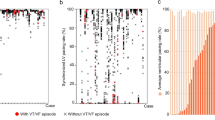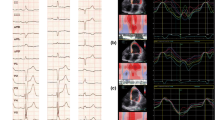Abstract
Purpose
Latency during left ventricle (LV) pacing has been suggested as a potential cause of ineffectual biventricular pacing. We assessed the incidence, predictors, and impact on outcome of increased LV latency in 274 patients undergoing cardiac resynchronization therapy (CRT).
Methods
On implantation, the latency interval was defined as the shortest stimulus-to-QRS onset interval in any lead of the 12-lead ECG. A stimulus-to-QRS onset interval ≥ 40 ms was used to define the presence of increased LV latency.
Results
Increased LV latency was observed in 55 patients (20%). On multivariate analysis, only ischemic etiology proved to be a predictor of increased LV latency. On 12-month echocardiographic evaluation, 68% patients showed a ≥ 15% decrease in LV end systolic volume (74% patients with increased LV latency, 67% patients without increased LV latency (p = 0.58). The presence of increased LV latency was not associated with a different clinical response to CRT.
Conclusions
Increased LV latency occurred in almost 20% of patients undergoing CRT and was more frequent in patients with ischemic heart disease. The presence of increased LV latency does not seem to have an impact on echocardiographic or clinical response to CRT.




Similar content being viewed by others
References
Yancy CW, Jessup M, Bozkurt B, Butler J, Casey DE Jr, Drazner MH, et al. American College of Cardiology Foundation/American Heart Association Task Force on Practice Guidelines. 2013 ACCF/AHA Guideline for the Management of Heart Failure: a report of the American College of Cardiology Foundation/American Heart Association Task Force on Practice Guidelines. Circulation. 2013;128(16):e240–327. https://doi.org/10.1161/CIR.0b013e31829e8776.
Brignole M, Auricchio A, Baron-Esquivias G, Bordachar P, Boriani G, Breithardt OA, et al. 2013 ESC Guidelines on cardiac pacing and cardiac resynchronization therapy: the Task Force on cardiac pacing and resynchronization therapy of the European Society of Cardiology (ESC). Developed in collaboration with the European Heart Rhythm Association (EHRA). Eur Heart J. 2013;34:2281–329.
Bristow MR, Saxon LA, Boehmer J, Krueger S, Kass DA, De Marco T, et al. Comparison of Medical Therapy, Pacing, and Defibrillation in Heart Failure (COMPANION) Investigators. Cardiac-resynchronization therapy with or without an implantable defibrillator in advanced chronic heart failure. N Engl J Med. 2004;350(21):2140–50. https://doi.org/10.1056/NEJMoa032423.
Cleland JG, Daubert JC, Erdmann E, Freemantle N, Gras D, Kappenberger L, et al. The effect of cardiac resynchronization on morbidity and mortality in heart failure. N Engl J Med. 2005;352(15):1539–49. https://doi.org/10.1056/NEJMoa050496.
Auricchio A, Prinzen FW. Non-responders to cardiac resynchronization therapy: the magnitude of the problem and the issues. Circ J. 2011;75(3):521–7. https://doi.org/10.1253/circj.CJ-10-1268.
Daubert C, Behar N, Martins RP, Mabo P, Leclercq C. Avoiding non-responders to cardiac resynchronization therapy: a practical guide. Eur Heart J. 2016:ehw270. https://doi.org/10.1093/eurheartj/ehw270.
Herweg B, Ilercil A, Madramootoo C, Krishnan S, Rinde-Hoffman D, Weston M, et al. Latency during left ventricular pacing from the lateral cardiac veins: a cause of ineffectual biventricular pacing. Pacing Clin Electrophysiol. 2006;29:574–81.
Herweg B, Ali R, Ilercil A, Madramootoo C, Cutro R, Weston MW, et al. Site-specific differences in latency intervals during biventricular pacing: impact on paced QRS morphology and echo-optimized V-V interval. Pacing Clin Electrophysiol. 2010;33(11):1382–91. https://doi.org/10.1111/j.1540-8159.2010.02882.x.
Dickstein K, Vardas PE, Auricchio A, Daubert JC, Linde C, McMurray J, et al. 2010 Focused Update of ESC Guidelines on device therapy in heart failure: an update of the 2008 ESC Guidelines for the diagnosis and treatment of acute and chronic heart failure and the 2007 ESC guidelines for cardiac and resynchronization therapy. Developed with the special contribution of the Heart Failure Association and the European Heart Rhythm Association. Eur Heart J. 2010;31:2677–87.
Stabile G, Bertaglia E, Botto G, Isola F, Mascioli G, Pepi P, et al. Cardiac Resynchronization Therapy MOdular REgistry: ECG and Rx predictors of response to cardiac resynchronization therapy (NCT01573091). J Cardiovasc Med (Hagerstown). 2013;14:886–93.
Surawicz B, Childers R, Deal BJ, Gettes LS, Bailey JJ, Gorgels A, et al. AHA/ACCF/HRS recommendations for the standardization and interpretation of the electrocardiogram: part III:intraventricular conduction disturbances: a scientific statement from the American Heart Association Electrocardiography and Arrhythmias Committee, Council on Clinical Cardiology; the American College of Cardiology Foundation; and the Heart Rhythm Society. Endorsed by the International Society for Computerized Electrocardiology. J Am Coll Cardiol. 2009;53(11):976–81. https://doi.org/10.1016/j.jacc.2008.12.013.
Packer M. Proposal for a new clinical end point to evaluate the efficacy of drugs and devices in the treatment of chronic heart failure. J Card Fail. 2001;7(2):176–82. https://doi.org/10.1054/jcaf.2001.25652.
Barold SS, Herweg B. Usefulness of the 12-lead electrocardiogram in the follow-up of patients with cardiac resynchronization devices. Part II. Cardiol J. 2011;18(6):610–24. https://doi.org/10.5603/CJ.2011.0024.
Klein HO, Di Segni E, Kaplinsky E, Schamroth L. The Wenckebach phenomenon between electric pacemaker and ventricle. Br Heart J. 1976;38(9):961–5. https://doi.org/10.1136/hrt.38.9.961.
Kistler PM, Mond HG, Vohra JK. Pacemaker ventricular block. Pacing Clin Electrophysiol. 2003 Oct;26(10):1997–9. https://doi.org/10.1046/j.1460-9592.2003.00308.x.
Tamborero D, Mont L, Sitges M, Silva E, Berruezo A, Vidal B, et al. Optimization of the interventricular delay in cardiac resynchronization therapy using the QRS width. Am J Cardiol. 2009;104:1407–12.
Author information
Authors and Affiliations
Corresponding author
Ethics declarations
The Institutional Review Board of each participating center approved the protocol, and each patient provided written informed consent before enrollment.
Conflict of interest
Roberto Ospizio, Greta Merlotti, and Maurizio Malacrida are employees of Boston Scientific, Inc. No other conflicts of interest exist.
Rights and permissions
About this article
Cite this article
D’Onofrio, A., Caico, S.I., Iuliano, A. et al. Incidence, predictors, and impact on outcome of increased left ventricular latency in patients undergoing cardiac resynchronization therapy. J Interv Card Electrophysiol 51, 245–252 (2018). https://doi.org/10.1007/s10840-018-0321-7
Received:
Accepted:
Published:
Issue Date:
DOI: https://doi.org/10.1007/s10840-018-0321-7




